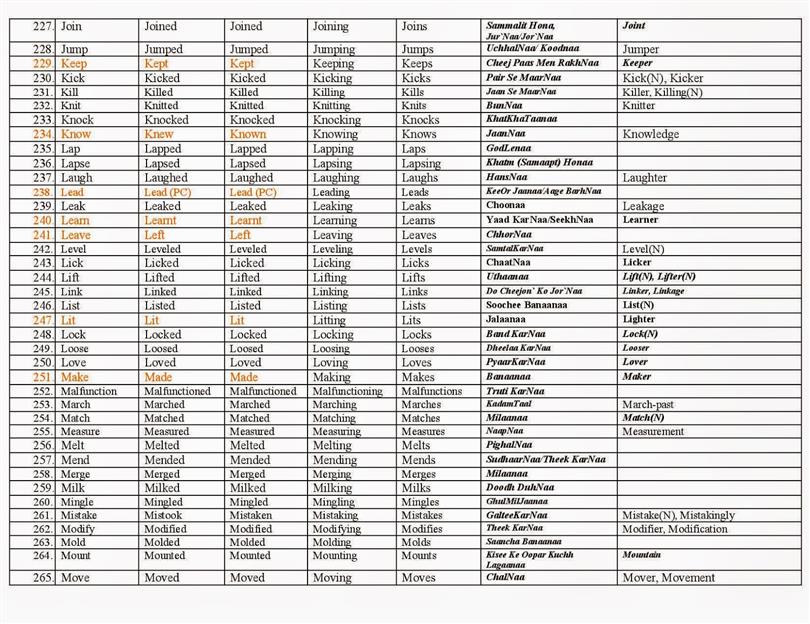

Questions? Found a mistake? Leave a comment below. Of course, there are many more irregular verbs in English. I hope these exercises on irregular verbs have been useful. Even though it was damaged, her friend (forgive) her when she returned it. She had (tear) it and also (bleed) onto it a little.
When Laura (fall) off her bicycle, she (tear) the dress she was wearing and (cut) her knee. The child (sneak) behind the counter at the bakery and (stick) his finger in a cake. During the flood of 2008, water levels (rise) to dangerous levels. The news quickly (spread) that the president had been (shoot). Volunteers are being (seek) for language teaching positions. One day irregular verbs may disappear from English, but for now, it’s important for every student to learn them. Check out this list of the 30 most common verbs in the English languageThe verbs are listed in their base form, present tense, past tense, and perfect forms. On strategy is to focus on the most commonly used words. Scroll down or click here to do exercises on the above irregular verb list for beginner students. Many students ask which words they should learn first. Here is a list of 45 irregular verbs that beginner ESL students should learn. There are over 400 English verbs that use an irregular form. Passive Voice ( be + past participle): My arm was broken yesterday. Past Perfect ( had + past participle ): I hadn’t broken my arm until I started snowboarding. Present Perfect ( have + past participle): I have broken my arm twice in my life. #A LIST OF COMMON ENGLISH IRREGULAR VERBS HOW TO#
How to Teach English Conversation Class. 'Be used to'" / 'Use to' / 'Get used to'. The Difference between "Other" & "Another". The Difference between 'a few/few/a little/little'. The truth is that you won't master English without studying them. There's no real trick to learning how to use irregular verbs. You can test yourself with these fun irregular verbs quizzes. Of course, there are many others, but these are the more common irregular verbs. So, if you're learning or teaching English, you must embrace them. This is a list of some irregular verbs in English. Somewhat counter-intuitively, the most common verbs in English are irregular. Here is a Venn diagram that explains how verbs are classified: Similarly, the terms "regular verb" and "weak verb" are not synonyms. The terms "irregular verb" and "strong verb" are not synonyms (i.e., they do not mean the same). Infographic Explaining Strong, Weak, Regular, and Irregular Verbs Here are some examples of strong and weak irregular verbs: Irregular Verbs Can Be Strong or Weak VerbsĪn irregular verb can be either a weak verb (when its past forms end "–d" or "-t") or a strong verb. Some irregular verbs do not change their forms for the simple past tense and the past participle: 
learnt, dreamt) is more common in British English. There is a set of worksheets to practice some verbs that students commonly confuse in our grade 2 grammar section. For practice, here’s a list of the 50 most common irregular verbs. For example: go, went, gone or do, did, done. The following verbs can be regular or irregular: They’re called irregular verbs and many happen to be verbs that are used often. Listed below are the most common irregular verbs in English: The Most Common Irregular Verbs in English Now, compare those irregular forms with those of regular verbs, which just add "-ed" or "-d": With an irregular verb, the past form and past participle are often different (but not always).

It is somewhat ironic that the most regularly used verbs in English are irregular. Use the buttons to form the past tense and then the participle of the irregular verb shown. (There are spelling rules to consider when forming the simple past tense or past participle of a regular verb.) Irregular verbs contrast with regular verbs, which form the simple past tense and past participle by adding "-ed" or "-d." What Are Irregular Verbs? (with Examples)Īn irregular verb is one that does not form its simple past tense or its past participle by adding "-ed" or "-d" to the base form.







 0 kommentar(er)
0 kommentar(er)
